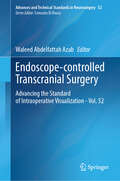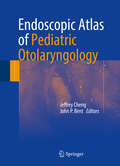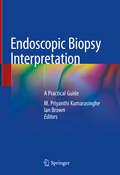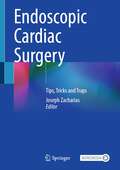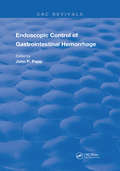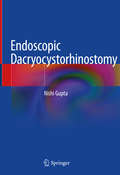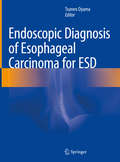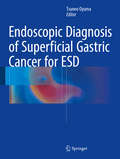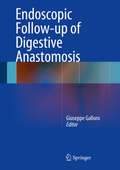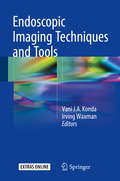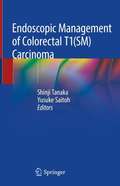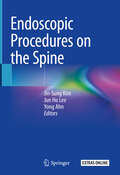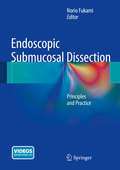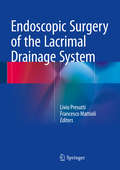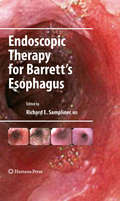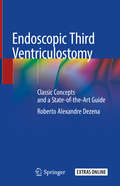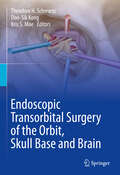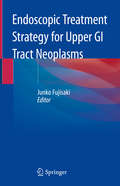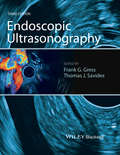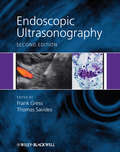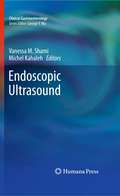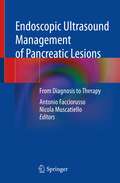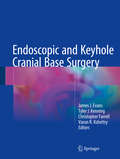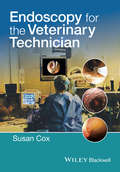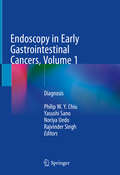- Table View
- List View
Endoscope-controlled Transcranial Surgery: Advancing the Standard of Intraoperative Visualization - Vol. 52 (Advances and Technical Standards in Neurosurgery #52)
by Waleed Abdelfattah AzabThis book addresses the fully endoscopic or endoscope-controlled transcranial surgery. As a surgical philosophy, it entails that the whole procedure is performed through a tailored keyhole craniotomy under the exclusive control of the rigid endoscope without the use of other visualization tools like surgical microscopes or exoscopes. Despite the well-known extreme superiority of the endoscopic view, especially at deep surgical targets, performing surgery under pure endoscopic control is currently adopted by few neurosurgeons across the globe. The main objective of this book to shed the light on this minimally-invasive surgical methodology and demonstrate its advantages and practical do ability. Many internationally renowned expert neurosurgeons thoroughly describe how these procedures are performed using detailed descriptions of the surgical techniques and high-quality illustrations and exquisite intraoperative endoscopic images. Endoscope-controlled Transcranial Surgery will be a valuable guide to practicing neurosurgeons in raising the bar of intraoperative visualization, with a consequent great improvement of safety and efficacy of the procedure performed. Furthermore, the book will serve as a starting point for more widespread utilization and dispersion of this surgical philosophy in the future.
Endoscopic Atlas of Pediatric Otolaryngology
by Jeffrey Cheng John P. P. BentThis volume is an invaluable reference for the practicing pediatrician, audiologist, speech pathologist, nurse practitioner, physician assistant, and other allied health professionals, as well as the pediatric otolaryngologist, including pediatric otolaryngology fellows and residents. Organized into primary chapters covering the topics of otology, rhinology, and laryngology/bronchoesophagology, each image is accompanied by a short description and brief overview/review of the pathology. While not meant to be all-encompassing of pediatric otolaryngology pathology encountered in practice, Endoscopic Atlas of Pediatric Otolaryngology is an essential tool for office and training programs to help educate patients and families.
Endoscopic Biopsy Interpretation: A Practical Guide
by Ian Brown M. Priyanthi KumarasingheThe volume of endoscopic biopsies being performed continues to grow rapidly and they now represent one of the most common specimens encountered in routine surgical pathology practice. It is essential to maintain the balance between the speed and accuracy while integrating emerging sophisticated pathology techniques into endoscopic biopsies in routine practice. Microscopic appearance is virtually diagnostic of certain diseases. In others a diagnosis may be rendered only after correlating the microscopic pattern with clinical clues aided by ancillary tests.This text provides a guide to systematic approach of endoscopic biopsies to render a safe, quick and accurate pathological diagnosis in an integrated manner as well as important information that pathologists and clinicians should know to get the best value of endoscopic biopsies. The first chapter introduces the key microscopic features that are normal and abnormal in the gut mucosa as appreciated in an endoscopic biopsy. The second chapter presents a general overview highlighting the neoplastic and non-neoplastic patterns that are common to the entire tubular gut. Because some patterns are common to many sites, an overarching chapter gives the reader a generalized approach, which will be further refined in subsequent site specific chapters. The disease etiologies of each pattern are discussed, with emphasis placed on the most common causes that will be encountered in clinical practice. The subsequent chapters that follow then concentrate on patterns encountered at specific anatomical locations. Under each anatomical location (esophagus, stomach, small intestine and large intestine) site specific patterns of both neoplastic and non-neoplastic conditions are described. Conditions that affect many sites in the gastrointestinal tract are discussed in detail in the most relevant site chapter, but are referred to in other chapters as the reaction pattern/s they produce at that site is discussed. Ancillary tests that are required for a diagnosis of some diseases in particular neoplastic conditions are listed with tips for interpretation. This is presented mostly in a table format to assist day-to-day quick reference. In keeping with recent advances of using small biopsies for testing clinically relevant bio markers, important information that the pathologists and clinicians need to know is highlighted in appropriate sites. Authored by experts in the field, each chapter is presented under headings that include diagnostic features, patterns with relevant endoscopic and clinical clues, traps and overlapping features, and appropriate ancillary tests including clinically relevant molecular signatures in endoscopic biopsies.
Endoscopic Cardiac Surgery: Tips, Tricks and Traps
by Joseph ZachariasThis book is unique in describing the practical considerations of endoscopic cardiac surgery. It covers this topic from basic concepts such as patient selection to imaging and outlines the different approaches to particular endoscopic cardiac surgical procedures. As there is an increasing acceptance that cardiac surgery needs to be provided to older and sicker patients and more asymptomatic patients, the option of a sternotomy is becoming less appealing. The endoscope has changed the patient pathway in many surgical specialities, but until recently cardiac surgery has been slow to adopt this approach. With improvements in imaging and better imaging technology, there is a steady increase in accepted procedures and trained surgeons offering this approach. Endoscopic Cardiac Surgery: Tips, Tricks and Traps captures the experience of endoscopic cardiac surgeons from around the world and is a concise yet thorough reference book for those starting a program in this discipline. With over 3 hours of associated video material, it will be an essential primer for the discipline, therefore making it a valuable reference for trainees in cardiac surgery and experienced surgeons wishing to add this approach to their armamentarium. Via app: download the SN More Media app for free, scan a link with play button and access MP4 directly on your smartphone or tablet.
Endoscopic Control Of Gastrointestinal Hemorrhage (Routledge Revivals)
by John P. PappPublished in 1981: This book has been written to present the state of the art on endoscopic control of gastrointestinal haemorrhage with emphasis on combining the clinical approach to the patient while reviewing the experimental data which has resulted in the availability of various modalities of therapy.
Endoscopic Dacryocystorhinostomy
by Nishi GuptaThis book explains and elaborates upon the procedure of endoscopic dacryocystorhinostomy in a variety of indications.It systematically deals with the anatomy of the lacrimal drainage system, covering all aspects of gross, endoscopic and radiological anatomy.It discusses extensively on the preoperative assessment involving clinical and radiological evaluation as it is a crucial step towards achieving a successful dacryocystorhinostomy.It uses a lot of clinical and schematic diagrams of the surgical steps, simplifying the layout of the procedure and thus making it very easy for the eye and ENT surgeons to follow the technique. The book covers from basic to the most advanced and minimally invasive procedures likedacryoendoscopy and balloon dacryoplasty.It also provides a few handy tips for the upcoming young oculoplastic surgeons, ENT surgeons and postgraduate students.
Endoscopic Diagnosis of Esophageal Carcinoma for ESD
by Tsuneo OyamaThis volume addresses three general themes in the preoperative diagnosis of early-stage esophagus cancer starting. Beginning with detailed observations of diagnosis using Endoscopic Submucosal Dissection (ESD), subsequent sections describe the current medical treatments for various types of carcinoma and conclude with detailed explanations of difficult cases and their diagnoses. The book also includes a wealth of endoscopic and pathological figures, helping scholars understand the diagnosis and treatment visually. Endoscopic Diagnosis of Superficial Esophagus Cancer for ESD is an essential book for clinicians and professionals in the fields of endoscopy and gastroenterology, offering them a comprehensive guide to diagnosis and treatment using ESD. Further, it is a valuable companion piece to the Editor’s well-received book Endoscopic Diagnosis of Superficial Gastric Cancer for ESD.
Endoscopic Diagnosis of Superficial Gastric Cancer for ESD
by Tsuneo OyamaThis book focuses on the preoperative diagnosis of early-stage gastric cancer, presenting various cases and their diagnoses using Endoscopic Submucosal Dissection (ESD), a new technique for dissecting early-stage gastric cancer. The first chapter presents different cases with precise explanations and observations, thus providing basic knowledge of invasion depth diagnosis, diagnostic coverage, and qualitative diagnosis. The second part of this book further expands on these topics with more examples and current practices before concluding with an in-depth look at the application in difficult-to-treat cases, complete with a vast range of figures and detailed diagnoses. Edited and authored by pioneering researchers in the field, Preoperative Diagnosis of Gastric Cancer is designed as a textbook for clinicians and professionals in the fields of endoscopy and gastroenterology.
Endoscopic Follow-up of Digestive Anastomosis
by Giuseppe GalloroOwing to the alterations in visceral anatomy, many endoscopists, and especially trainees, experience difficulties when performing endoscopic surveys or procedures in patients who have previously undergone surgery to the digestive tract. In this richly illustrated book, an expert in the field provides a detailed overview of endoscopic follow-up of gastrointestinal (esophageal, gastric, and colorectal) anastomosis. Both normal appearances and pathological conditions involving complications are fully covered. The methodology, timing, protocols, and role of diagnostic endoscopy are first discussed. Endoscopic treatments for the resolution of different clinical problems related to recurrences, stenoses, dehiscences, and fistulas are then evaluated step by step with the aid of high-quality images. Regardless of level of experience, endoscopists and gastroenterologists will find Endoscopic Follow-up of Digestive Anastomosis to be an invaluable source of information and aid to treatment in this important area, which too often receives insufficiently detailed attention.
Endoscopic Imaging Techniques and Tools
by Vani J. A. Konda Irving WaxmanThis book is a comprehensive, state-of-the art update of the field of endoscopic imaging. The approaches to novel imaging and cutting edge techniques are demonstrated in the context of gastrointestinal endoscopic imaging, with discussions on both techniques in use and exploration of novel imaging platforms on the horizon in gastrointestinal endoscopy. Designed to convey practical information on these innovative approaches in a user-friendly manner, each chapter focuses on the principals of the technology under discussion, highlights key clinical indications, demonstrates the equipment and set up required, covers the basic technique, and reviews complication profiles, and comparison to standard or alternative approaches. Chapters also provides the expert's tips and tricks for the reader to more practically and easily translate the information provided into safe and successful practice. The volume is also accompanied by videos demonstrating highlighting certain techniques. Written by experts in the field, Endoscopic Imaging Techniques and Tools is a valuable resource for clinicians, trainees, and researchers interested in the field of endoscopic imaging.
Endoscopic Management of Colorectal T1(SM) Carcinoma
by Shinji Tanaka Yusuke SaitohThis book provides the latest information on diagnosis and treatment strategies for colorectal T1(SM) carcinoma including endoscopic resection, and pathologic diagnosis and treatment following resection. Due to constant advances, the curative phase after the endoscopic resection of carcinomas has extended, shifting the endpoints of diagnosis and treatment strategies. This book thoroughly summarizes the latest findings, explained with the help of abundant color figures, and will serve as a basis for further discussions and advances in this field. Endoscopic Management of Colorectal T1(SM) Carcinoma offers a valuable resource for colonoscopists, colorectal surgeons, and pathologists at all levels. The readers will discover diverse perspectives, provided by the contributing authors, and extensive discussions that are analyzed from Asian perspectives, which often differ from those found in Western texts.
Endoscopic Procedures on the Spine
by Jin-Sung Kim Jun Ho Lee Yong AhnThis book aims to familiarize readers with the overall scope of endoscopic surgeries for the treatment of various types of spinal disease. State of the art techniques for minimally invasive endoscopic procedures to the cervical, thoracic, and lumbar spine are precisely described. The coverage includes cutting-edge endoscopic solutions for spinal canal stenosis or instability and low back pain. All technical aspects are explained in detail, and the text is complemented by many helpful illustrations. A further key feature is the provision of accompanying surgical videos, which will be of value to both novice and experienced surgeons. As a result of recent technological advances, minimally invasive endoscopic procedures are now being used for the treatment of patients with spinal problems in various institutes across the world. It can be anticipated that, in the near future, these procedures will be regarded as mainstream in spine surgery. The authors hope that this book will motivate the reader to participate in this trend, which promises important benefits for patients.
Endoscopic Submucosal Dissection
by Norio FukamiThis volume educates physicians on the basic knowledge of ESD, from indication of this technique to assessing suitability and technical aspects of each important step. The text is structured to guide readers to understand the principles, including history, why ESD was designed and developed, indications, as well as how to evaluate lesions and perform actual procedures. Abundant photographs and diagrams illustrate the key points and promote "pattern recognition". The text also introduces gastroenterologists to early gastrointestinal lesions, which have not been recognized in clinical practice for many years. To assist in the treatment process of ESD, highly practical information is provided, separated by different anatomical locations, as well as management of complications. The volume is also accompanied by an online video library. Written by experts in Asian countries with vast experience with this technique, as well as experts from the U. S. , South America, and Europe, Endoscopic Submucosal Dissection: Principles and Practice provides a major reference for gastroenterologists and surgeons on ESD.
Endoscopic Surgery of the Lacrimal Drainage System
by Livio Presutti Francesco MattioliThis manual covers all aspects of endoscopic surgery of the lacrimal drainage system. Step-by-step descriptions are provided of endoscopic dacryocystorhinostomy (DCR) and its use in revision surgery, accompanied by numerous helpful photographs and anatomical drawings. In addition, clear flow charts are included to aid in diagnostic and surgical decision making and identify surgical indications. Essential information is provided on anatomy, physiology and pathology and an individual chapter is devoted to imaging of the lacrimal drainage system. Further topics include lacrimal probes and stents, potential complications of surgery, and endoscopic DCR in the pediatric age group. This book will assist the practitioner in negotiating the steep learning curve involved in gaining the skills needed to perform endoscopic surgery of the lacrimal drainage system, which offers significant advantages in terms of avoidance of external incisions and maintenance of the lacrimal pump.
Endoscopic Therapy for Barrett's Esophagus
by Richard E. SamplinerEndoscopic Therapy is emerging as the preferred therapy for early neoplasia in Barrett's Esophagus. This volume provides the key decision making factors in determining endoscopic therapy for an individual patient. All current techniques and complications of ET are provided including, photodynamic therapy (PDT), APC, multipolar electrocoagulation (MPEC), RF, ER, and cryotherapy. Each technique includes "how to highlights", high quality color endoscopic images, line drawings and diagrams. Endoscopic imaging modalities to detect dysplasia, decision making in the clinical arena and cost-effectiveness of ablation are some of the additional topics discussed in this highly practical volume. Written by experts in the field of endoscopic therapy, this text educates GI practitioners and researchers about this under-utilized approach to the treatment of Barrett's Esophagus.
Endoscopic Third Ventriculostomy: Classic Concepts and a State-of-the-Art Guide
by Roberto Alexandre DezenaEndoscopic third ventriculostomy is the most widely performed neuroendoscopic procedure around the world. Several scientific papers appear in the scientific literature every month, with an increasing number, given the great interest neuroendoscopy has aroused as well as controversies about certain aspects of endoscopic third ventriculostomy. With this reasoning, the goal of this book is to be a reference in the revision of classic concepts and scientifically proven aspects about the indications and techniques of endoscopic third ventriculostomy, as well as new neuroendoscopic tendencies. The book is structured in 2 parts and into 7 chapters. Part I – Classic Concepts – comprises the first 2 chapters, covering general aspects of neuroendoscopy such as historical notes, endoscopic anatomy and ventricular system physiology. Part II – State-of-the-Art – comprises chapters 3 to 7. From chapters 3 to 6 the book will discuss general principles of endoscopic ventricular technique and the applications of endoscopic third ventriculostomy in different age groups, and its association to choroid plexus coagulation. Chapter 7 deals with alternative ways of communicating the ventricular system with the cisterns of the subarachnoid space. All chapters are richly illustrated with high resolution images; there are links to online access to demonstrative surgical videos. Designed for neurosurgeons at every level, the book will be unique in the market, as there is no similar book in the current scientific literature that specifically discusses endoscopic third ventriculostomy in its broadest sense.
Endoscopic Transorbital Surgery of the Orbit, Skull Base and Brain
by Theodore H. Schwartz Doo-Sik Kong Kris S. MoeEndoscopic transorbital surgery of the orbit, skull base and brain is a new surgical discipline that has developed over the last decade out of a collaboration between otolaryngologists, neurosurgeons and oculoplastic surgeons. Tumors and other pathology of the skull base are some of the most difficult to approach and treat for surgeons since they lie at the interface of several traditional specialties, namely the eye, the paranasal sinuses and the brain. For this reason, no single surgical specialty is fully trained to independently reach this region, which requires collaborative approaches that are technically demanding and often long and arduous procedures. In the last decade, using the endoscopic techniques and instrumentation, otolaryngologists, oculoplastic surgeons and neurosurgeons, have together shown that the orbit can be used as a minimally disruptive corridor to reach the skull base lateral to the carotid artery as well as other areas that are difficult to access through transcranial or endonasal approaches. These approaches are now even being used to remove brain tumors involving the frontal and temporal lobes, including those that extend through the middle cranial fossa and into the posterior fossa, without visible external scars or the need for a traditional craniotomy. In addition, they have been used to clip aneurysms, treat seizure disorders, drain abscesses, repair CSF (brain fluid) leaks, and restore skull fractures – all without the additional risks, trauma and prolonged recovery of previous open surgical techniques. The literature is now demonstrating that these endoscopic procedures have comparable or improved safety compared to open surgery, while creating less collateral damage, and result in reduced patient stays. Due to their novelty, few surgeons have acquired the necessary experience, knowledge and expertise to introduce these approaches into their practice, yet due to their safety and efficacy they are rapidly becoming a critical skill set. This is the first text of its kind to codify and proliferate these new approaches more rapidly through the country and world, appealing to otolaryngologists, oculoplastic surgeons and neurosurgeons who deal with pathology involving the skull base.
Endoscopic Treatment Strategy for Upper GI Tract Neoplasms
by Junko FujisakiThis book presents various cases of upper GI tract neoplasms, discussing endoscopic diagnostic procedures and treatment strategies, such as white light endoscopy (WLE ), magnified endoscopy with narrow band imaging (NBI) and endoscopic ultrasonography (EUS). Focusing on the esophagus, stomach and duodenum, it provides user-friendly, practical information on these innovative approaches, and explores treatments, pathological insights, including target biopsy, and therapies for specific cases. Endoscopic Treatment Strategy for Upper GI Tract Neoplasms appeals to a wide readership, from trainees to experienced gastroenterologists. It presents research evidence to broaden readers’ understanding and enable them to optimize outcomes for patients.
Endoscopic Ultrasonography
by Thomas J. Savides Frank G. GressYear on year, there continue to be dramatic changes in endoscopic ultrasonography (EUS) since it was first introduced 30 years ago. Advances in technology have meant that as well as being used in the diagnosis of gastrointestinal disorders, EUS is now one of the primary diagnostic and therapeutic modalities used in GI endoscopy. Back and improved for a new edition, Endoscopic Ultrasonography is the market-leading book covering the topic. Written by leading experts in the field, it provides a technical how-to approach to learning this advanced endoscopic procedure. The highly-acclaimed authors provide step-by-step guidance to the fundamentals of EUS, giving clear instructions on the instruments involved, the correct sedation procedures to follow and how EUS should be performed safely and effectively. Every chapter discusses a specific aspect of EUS as it relates to a particular gastrointestinal disorder or organ system. Brand new to this edition are: 1) Seven new chapters on the hottest topics in EUS: Learning Anatomy for EUS; Elastography; Lung Cancer; Autoimmune Pancreatitis; EUS for Liver Disease; Biliary Access; Pancreatic Fluid Collection Drainage 2) A complete update of all previous chapters to reflect the most current clinical recommendations 3) A host of new color images in every chapter Endoscopic Ultrasonography 3rd edition is the ideal tool to consult to improve EUS skills and improve patient management, and an essential purchase for all gastroenterologists and endoscopists.
Endoscopic Ultrasonography
by Frank G. GressWant to learn how to use EUS in the treatment of pancreatic cysts? Need a refresher on how to perform EUS fine needle aspiration? This is the book for you! There have been dramatic changes since endoscopic ultrasound (EUS) was first introduced 30 years ago. Advances in technology have meant that as well as being used in the diagnosis of gastrointestinal disorders, EUS is now an accepted therapeutic modality. This second edition covers these exciting changes with new chapters on the emerging field of therapeutic EUS. The book provides a technical how-to approach to learning this advanced endoscopic procedure. The authors guide you, step-by-step, through the fundamentals of EUS with instructions on: the instruments involved sedation procedures how EUS should be performed Each chapter discusses a specific aspect of EUS as it relates to a particular gastrointestinal disorder or organ system. Drawing on the vast experience of the authors, this definitive volume contains clear and practical guidance on the state of the art in EUS practice today.
Endoscopic Ultrasound (Clinical Gastroenterology)
by Michel Kahaleh Vanessa M. ShamiEndoscopic ultrasound has revolutionized the approach to lesions inside and outside the gastrointestinal tract. It has opened the door for gastroenterologists to explore organs outside of the GI lumen, such as the lymph nodes, lung, pancreas, and liver. Endoscopic Ultrasound covers all aspects of endoscopic ultrasound, from the basics to the interventional indications. Richly detailed chapters describe the utility of EUS in different parts of the body and are organized based on body site Pioneers in the field summarize new studies, and the direction of EUS in practice. Endoscopic Ultrasound provides a ready reference that will help physicians and support staff that are beginning EUS, as well as trained ultrasonographers who wish to arm themselves with a comprehensive reference and explore the future of the field.
Endoscopic Ultrasound Management of Pancreatic Lesions: From Diagnosis to Therapy
by Antonio Facciorusso Nicola MuscatielloThis book provides a comprehensive and up-to-date overview of current endoscopic ultrasound use in all aspects of pancreatology, from diagnosis to therapy, i.e., from tissue acquisition, with standard fine-needle aspiration and the newer biopsy needles, to less invasive techniques such as contrast-enhanced ultrasound and elastography. It also covers novel therapeutic strategies, with a particular focus on ablative treatments and lumen-apposing stents, and describes techniques developed by the editors, in particular combined celiac plexus neurolysis with pancreatic tumor ethanol ablation and elastography-guided fine-needle aspiration. All topics are developed by pursuing an evidence-based approach and several recent meta-analyses, the majority of which were published by the authors. Due to several recent advances in the field, endoscopic ultrasound has taken on a pivotal role in the diagnosis, staging, and treatment of pancreatic lesions; as such, the present volume offers an invaluable tool for staying abreast of the state-of-the-art in this field.
Endoscopic and Keyhole Cranial Base Surgery
by James J. Evans Tyler J. Kenning Christopher Farrell Varun R. KshettryThe first two sections of this text address endoscopic and keyhole surgical procedures for cranial base and deep brain structures. These sections provide a comprehensive, state-of-the art review of this minimally invasive field and will serve as a valuable resource for clinicians, surgeons and researchers with an interest in cranial base surgery. The philosophy, techniques, indications and limitations of endoscopic and keyhole cranial base surgery are covered in detail. This reference includes a discussion of the basic principles of these approaches as well as the preoperative planning, intraoperative pearls, and reconstruction techniques. The thorough descriptions of the practical and technical aspects are accompanied by extensive illustrations, figures and operative images. <p><p> Extending beyond the technical details of these procedures, this text provides a third section that focuses on a thorough analysis and comparison of the endoscopic, keyhole and traditional open approaches to specific intracranial regions. Utilizing a “target-based” approach, the utility of each surgical technique is evaluated in regard to accessing pathology of the anterior, middle and posterior fossa cranial base as well as the deep central regions of the brain. All chapters are written by experts in their fields and include the most up to date scientific and clinical information. <p> Endoscopic and Keyhole Cranial Base Surgery will be a valuable resource to specialists in optimizing surgical results and improving patient outcomes.
Endoscopy for the Veterinary Technician
by Susan CoxEndoscopy for the Veterinary Technician is a comprehensive resource for the proper care and handling of endoscopes and accompanying instrumentation for a variety of procedures. An inclusive reference on the proper care and handling of endoscopes and instrumentation Provides step-by-step details on a variety of endoscopic procedures, highlighting patient preparation, needed equipment, anesthesia, post-procedure care, and complications Offers numerous color images to help identify equipment and provide a visual guide to procedures Includes specific technician tips throughout the text
Endoscopy in Early Gastrointestinal Cancers, Volume 1: Diagnosis
by Yasushi Sano Philip W. Y. Chiu Noriya Uedo Rajvinder SinghEndoscopy in Early Gastrointestinal Cancers, Volume 1: Diagnosis provides detailed information of the technique of novel endoscopic diagnostic tools including magnifying endoscopy, narrow band imaging system (NBI), autofluorescence endoscopy (AFI), endocytoscopy, FICE and confocal endomicroscopy. Carcinoma of the gastrointestinal tract remained a major health issue worldwide, which is, however notoriously difficult to treat. One of the major reasons for such a poor result is that these cancers are diagnosed at advanced stage. There is a recent increase in the number of gastrointestinal cancers diagnosed at early stage. This is attributed to an increasing recognition of these early stage cancers through a recent development in the technology of endoscopy. This book on the endoscopic diagnosis of early GI neoplasia, containing lots of illustrations, artwork and numerous short video clips, serves as a bridge between the recent development in endoscopy and the knowledge of gastroenterologist, endoscopist and surgeons.
